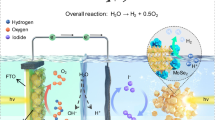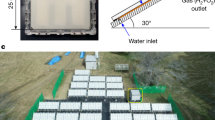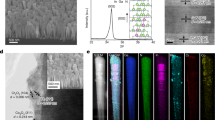Abstract
Sunlight-driven photocatalytic water splitting has been studied as a means of producing renewable green solar hydrogen on a large scale at low cost. However, the research community has yet to define a common vision for practical solar hydrogen production, which requires not only photocatalyst materials that drive water-splitting reactions with high efficiency under sunlight but also systems and processes that can be scaled up. Herein, we discuss the current status and challenges in the development of materials, systems and processes for solar hydrogen production via photocatalytic water splitting. Despite the remarkable scientific progress in the development of photocatalyst materials and reaction systems over the past decade, many technological challenges remain before this technology can be put to practical use in terms of efficiency improvement, mass production, large-scale application of photocatalysts, cost reduction, process-efficiency improvement for reaction systems, and societal acceptance. It is, therefore, imperative to stimulate and accelerate research and development and large-scale demonstrations of hydrogen production via photocatalytic water splitting through collaborative efforts among industry, government and academia.
This is a preview of subscription content, access via your institution
Access options
Access Nature and 54 other Nature Portfolio journals
Get Nature+, our best-value online-access subscription
$32.99 / 30 days
cancel any time
Subscribe to this journal
Receive 12 digital issues and online access to articles
$119.00 per year
only $9.92 per issue
Buy this article
- Purchase on SpringerLink
- Instant access to full article PDF
Prices may be subject to local taxes which are calculated during checkout







Similar content being viewed by others
References
Hisatomi, T. & Domen, K. Reaction systems for solar hydrogen production via water splitting with particulate semiconductor photocatalysts. Nat. Catal. 2, 387–399 (2019).
Farmer, J. D. & Lafond, F. How predictable is technological progress? Res. Policy 45, 647–665 (2016).
AlMallahi, M. N., Swailmeen, Y. A., Abdelkareem, M. A., Olabi, A. G. & Elgendi, M. A path to sustainable development goals: a case study on the thirteen largest photovoltaic power plants. Energy Convers. Manag. X 22, 100553 (2024).
Victoria, M. et al. Solar photovoltaics is ready to power a sustainable future. Joule 5, 1041–1056 (2021).
Kim, J. H., Hansora, D., Sharma, P., Jang, J.-W. & Lee, J. S. Toward practical solar hydrogen production — an artificial photosynthetic leaf-to-farm challenge. Chem. Soc. Rev. 48, 1908–1971 (2019).
Wang, Y. et al. Mimicking natural photosynthesis: solar to renewable H2 fuel synthesis by Z-scheme water splitting systems. Chem. Rev. 118, 5201–5241 (2018).
Kranz, C. & Wächtler, M. Characterizing photocatalysts for water splitting: from atoms to bulk and from slow to ultrafast processes. Chem. Soc. Rev. 50, 1407–1437 (2021).
Tao, X., Zhao, Y., Wang, S., Li, C. & Li, R. Recent advances and perspectives for solar-driven water splitting using particulate photocatalysts. Chem. Soc. Rev. 51, 3561–3608 (2022).
Ivanova, M. E. et al. Technological pathways to produce compressed and highly pure hydrogen from solar power. Angew. Chem. Int. Ed. 62, e202218850 (2023).
Gunawan, D. et al. Materials advances in photocatalytic solar hydrogen production: integrating systems and economics for a sustainable future. Adv. Mater. 36, 2404618 (2024).
Hisatomi, T. & Domen, K. Introductory lecture: sunlight-driven water splitting and carbon dioxide reduction by heterogeneous semiconductor systems as key processes in artificial photosynthesis. Faraday Discuss. 198, 11–35 (2017).
Miseki, Y. & Sayama, K. Highly efficient Fe(III) reduction and solar-energy accumulation over a BiVO4 photocatalyst. Chem. Commun. 54, 2670–2673 (2018).
Zhao, Y. et al. A hydrogen farm strategy for scalable solar hydrogen production with particulate photocatalysts. Angew. Chem. Int. Ed. 59, 9653–9658 (2020).
Fu, H. et al. A scalable solar-driven photocatalytic system for separated H2 and O2 production from water. Nat. Commun. 16, 990 (2025).
Nakamura, A. et al. A 24.4% solar to hydrogen energy conversion efficiency by combining concentrator photovoltaic modules and electrochemical cells. Appl. Phys. Express 8, 107101 (2015).
Jia, J. et al. Solar water splitting by photovoltaic-electrolysis with a solar-to-hydrogen efficiency over 30%. Nat. Commun. 7, 13237 (2016).
Shaner, M. R., Atwater, H. A., Lewis, N. S. & McFarland, E. W. A comparative technoeconomic analysis of renewable hydrogen production using solar energy. Energy Environ. Sci. 9, 2354–2371 (2016).
Sathre, R. et al. Opportunities to improve the net energy performance of photoelectrochemical water-splitting technology. Energy Environ. Sci. 9, 803–819 (2016).
Takata, T. et al. Photocatalytic water splitting with a quantum efficiency of almost unity. Nature 581, 411–414 (2020).
Wang, Q. et al. Oxysulfide photocatalyst for visible-light-driven overall water splitting. Nat. Mater. 18, 827–832 (2019).
Li, H. et al. One-step excitation overall water splitting over a modified Mg-doped BaTaO2N photocatalyst. ACS Catal. 12, 10179–10185 (2022).
Kaiya, K. et al. Water splitting over transition metal-doped SrTiO3 photocatalysts with response to visible light up to 660 nm. Chem. Sci. 15, 16025–16033 (2024).
Nishiyama, H. et al. Photocatalytic solar hydrogen production from water on a 100-m2 scale. Nature 598, 304–307 (2021).
Yamada, T. et al. Production of methane by sunlight-driven photocatalytic water splitting and carbon dioxide methanation as a means of artificial photosynthesis. ACS Eng. Au 3, 352–363 (2023).
Wang, Q. et al. Scalable water splitting on particulate photocatalyst sheets with a solar-to-hydrogen energy conversion efficiency exceeding 1%. Nat. Mater. 15, 611–615 (2016).
Wang, Q. et al. Particulate photocatalyst sheets based on carbon conductor layer for efficient Z-scheme pure-water splitting at ambient pressure. J. Am. Chem. Soc. 139, 1675–1683 (2017).
Domen, K., Kondo, J. N., Hara, M. & Takata, T. Photo- and mechano-catalytic overall water splitting reactions to form hydrogen and oxygen on heterogeneous catalysts. Bull. Chem. Soc. Jpn 73, 1307–1331 (2000).
Kudo, A. & Miseki, Y. Heterogeneous photocatalyst materials for water splitting. Chem. Soc. Rev. 38, 253–278 (2009).
Maeda, K. Photocatalytic water splitting using semiconductor particles: history and recent developments. J. Photochem. Photobiol. C Photochem. Rev. 12, 237–268 (2011).
Lin, L. et al. Photocatalytic overall water splitting by conjugated semiconductors with crystalline poly(triazine imide) frameworks. Chem. Sci. 8, 5506–5511 (2017).
Lin, L. et al. Molecular-level insights on the reactive facet of carbon nitride single crystals photocatalysing overall water splitting. Nat. Catal. 3, 649–655 (2020).
Hisatomi, T., Kubota, J. & Domen, K. Recent advances in semiconductors for photocatalytic and photoelectrochemical water splitting. Chem. Soc. Rev. 43, 7520–7535 (2014).
Hisatomi, T., Takanabe, K. & Domen, K. Photocatalytic water-splitting reaction from catalytic and kinetic perspectives. Catal. Lett. 145, 95–108 (2015).
Sato, S. & White, J. M. Photodecomposition of water over Pt/TiO2 catalysts. Chem. Phys. Lett. 72, 83–86 (1980).
Domen, K., Naito, S., Soma, M., Onishi, T. & Tamaru, K. Photocatalytic decomposition of water vapour on an NiO–SrTiO3 catalyst. J. Chem. Soc. Chem. Commun. 12, 543–544 (1980).
Lehn, J. M., Sauvage, J. P. & Ziessel, R. Photochemical water splitting. Continuous generation of hydrogen and oxygen on irradiation of aqueous suspensions of metal loaded strontium titanate. Nouv. J. Chim. 4, 623–627 (1980).
Chen, S., Takata, T. & Domen, K. Particulate photocatalysts for overall water splitting. Nat. Rev. Mater. 2, 17050 (2017).
Nishioka, S., Osterloh, F. E., Wang, X., Mallouk, T. E. & Maeda, K. Photocatalytic water splitting. Nat. Rev. Methods Primers 3, 42 (2023).
Takata, T. & Domen, K. Defect engineering of photocatalysts by doping of aliovalent metal cations for efficient water splitting. J. Phys. Chem. C 113, 19386–19388 (2009).
Kato, H., Kobayashi, M., Hara, M. & Kakihana, M. Fabrication of SrTiO3 exposing characteristic facets using molten salt flux and improvement of photocatalytic activity for water splitting. Catal. Sci. Technol. 3, 1733–1738 (2013).
Ham, Y. et al. Flux-mediated doping of SrTiO3 photocatalysts for efficient overall water splitting. J. Mater. Chem. A 4, 3027–3033 (2016).
Lyu, H. et al. An Al-doped SrTiO3 photocatalyst maintaining sunlight-driven overall water splitting activity for over 1000 h of constant illumination. Chem. Sci. 10, 3196–3201 (2019).
Goto, Y. et al. A particulate photocatalyst water-splitting panel for large-scale solar hydrogen generation. Joule 2, 509–520 (2018).
Yoshida, M. et al. Role and function of noble-metal/Cr-layer core/shell structure cocatalysts for photocatalytic overall water splitting studied by model electrodes. J. Phys. Chem. C 113, 10151–10157 (2009).
Scaife, D. E. Oxide semiconductors in photoelectrochemical conversion of solar energy. Sol. Energy 25, 41–54 (1980).
Maeda, K. & Domen, K. New non-oxide photocatalysts designed for overall water splitting under visible light. J. Phys. Chem. C 111, 7851–7861 (2007).
Maeda, K. et al. Photocatalyst releasing hydrogen from water. Nature 440, 295 (2006).
Liu, K. et al. Synthesis of narrow-band-gap GaN:ZnO solid solution for photocatalytic overall water splitting. ACS Catal. 12, 14637–14646 (2022).
Lee, Y., Teramura, K., Hara, M. & Domen, K. Modification of (Zn1+xGe)(N2Ox) solid solution as a visible light driven photocatalyst for overall water splitting. Chem. Mater. 19, 2120–2127 (2007).
Maeda, K., Lu, D. & Domen, K. Direct water splitting into hydrogen and oxygen under visible light by using modified TaON photocatalysts with d0 electronic configuration. Chem. Eur. J. 19, 4986–4991 (2013).
Pan, C. et al. A complex perovskite-type oxynitride: the first photocatalyst for water splitting operable at up to 600 nm. Angew. Chem. Int. Ed. 54, 2955–2959 (2015).
Pan, C., Takata, T. & Domen, K. Overall water splitting on the transition-metal oxynitride photocatalyst LaMg1/3Ta2/3O2N over a large portion of the visible-light spectrum. Chem. Eur. J. 22, 1854–1862 (2016).
Wang, Z. et al. Overall water splitting by Ta3N5 nanorod single crystals grown on the edges of KTaO3 particles. Nat. Catal. 1, 756–763 (2018).
Xiao, J. et al. Enhanced overall water splitting by a zirconium-doped TaON-based photocatalyst. Angew. Chem. Int. Ed. 61, e202116573 (2022).
Chen, K. et al. Overall water splitting by a SrTaO2N-based photocatalyst decorated with an Ir-promoted Ru-based cocatalyst. J. Am. Chem. Soc. 145, 3839–3843 (2023).
Liu, X. et al. Enhancing the photocatalytic activity of CaTaO2N for overall water splitting through surface nitride ion enrichment. ACS Catal. 14, 10561–10567 (2024).
Yu, J. et al. Single-crystalline LaTiO2N nanosheets with regulated defects for photocatalytic overall water splitting under visible light up to 600 nm. ACS Catal. 14, 608–618 (2024).
Iwase, A. & Misono, H. Development of visible-light-responsive Ir and La-codoped KTaO3 photocatalysts for water splitting. Chem. Commun. 57, 10331–10334 (2021).
Iwase, A., Kasahara, M. & Misono, H. Development of visible-light-responsive Ru-doped KTaO3 photocatalyst for overall water splitting with one-step photoexcitation and the effects of codoping with La. J. Mater. Chem. A 11, 22161–22166 (2023).
Iwase, A. & Sato, T. Overall water splitting under visible light irradiation over Ir and La-codoped NaTaO3 photocatalysts. J. Mater. Chem. A 12, 28346–28352 (2024).
Takata, T., Pan, C., Nakabayashi, M., Shibata, N. & Domen, K. Fabrication of a core–shell-type photocatalyst via photodeposition of group IV and V transition metal oxyhydroxides: an effective surface modification method for overall water splitting. J. Am. Chem. Soc. 137, 9627–9634 (2015).
Bau, J. A. & Takanabe, K. Ultrathin microporous SiO2 membranes photodeposited on hydrogen evolving catalysts enabling overall water splitting. ACS Catal. 7, 7931–7940 (2017).
Galvão, R. A. et al. Nanoparticulate TiN loading to promote Z-scheme water splitting using a narrow-bandgap nonoxide-based photocatalyst sheet. Small 20, 2311170 (2024).
Hisatomi, T. & Domen, K. Best practices for photocatalytic water splitting. Nat. Sustain. 7, 1082–1084 (2024).
Abe, R. Recent progress on photocatalytic and photoelectrochemical water splitting under visible light irradiation. J. Photochem. Photobiol. C Photochem. Rev. 11, 179–209 (2010).
Abe, R., Sayama, K., Domen, K. & Arakawa, H. A new type of water splitting system composed of two different TiO2 photocatalysts (anatase, rutile) and a IO3−/I− shuttle redox mediator. Chem. Phys. Lett. 344, 339–344 (2001).
Maeda, K. Z-scheme water splitting using two different semiconductor photocatalysts. ACS Catal. 3, 1486–1503 (2013).
Kato, H., Sasaki, Y., Shirakura, N. & Kudo, A. Synthesis of highly active rhodium-doped SrTiO3 powders in Z-scheme systems for visible-light-driven photocatalytic overall water splitting. J. Mater. Chem. A 1, 12327–12333 (2013).
Oshima, T. et al. An artificial Z-scheme constructed from dye-sensitized metal oxide nanosheets for visible light-driven overall water splitting. J. Am. Chem. Soc. 142, 8412–8420 (2020).
Xiao, J. et al. Sub-50 nm perovskite-type tantalum-based oxynitride single crystals with enhanced photoactivity for water splitting. Nat. Commun. 14, 8030 (2023).
Li, W. et al. Enhanced Z-scheme water splitting at atmospheric pressure with suppression of reverse reactions using Zr-doped BaTaO2N as hydrogen evolution photocatalyst. J. Catal. 428, 115187 (2023).
Liu, L. et al. Synthesis of highly active GaN:ZnO photocatalysts applicable to Z-scheme overall water splitting system. ACS Catal. 14, 10138–10147 (2024).
Lin, L. et al. Efficient and stable visible-light-driven Z-scheme overall water splitting using an oxysulfide H2 evolution photocatalyst. Nat. Commun. 15, 397 (2024).
Nakada, A., Saeki, A., Higashi, M., Kageyama, H. & Abe, R. Two-step synthesis of Sillén–Aurivillius type oxychlorides to enhance their photocatalytic activity for visible-light-induced water splitting. J. Mater. Chem. A 6, 10909–10917 (2018).
Hu, H. et al. Metal–organic frameworks embedded in a liposome facilitate overall photocatalytic water splitting. Nat. Chem. 13, 358–366 (2021).
Wang, W., Chen, J., Li, C. & Tian, W. Achieving solar overall water splitting with hybrid photosystems of photosystem II and artificial photocatalysts. Nat. Commun. 5, 4647 (2014).
Zhang, J. Z. & Reisner, E. Advancing photosystem II photoelectrochemistry for semi-artificial photosynthesis. Nat. Rev. Chem. 4, 6–21 (2020).
Qi, Y. et al. Unraveling of cocatalysts photodeposited selectively on facets of BiVO4 to boost solar water splitting. Nat. Commun. 13, 484 (2022).
Sasaki, Y., Nemoto, H., Saito, K. & Kudo, A. Solar water splitting using powdered photocatalysts driven by Z-schematic interparticle electron transfer without an electron mediator. J. Phys. Chem. C 113, 17536–17542 (2009).
Iwase, A., Ng, Y. H., Ishiguro, Y., Kudo, A. & Amal, R. Reduced graphene oxide as a solid-state electron mediator in Z-scheme photocatalytic water splitting under visible light. J. Am. Chem. Soc. 133, 11054–11057 (2011).
Jia, Q., Iwase, A. & Kudo, A. BiVO4–Ru/SrTiO3:Rh composite Z-scheme photocatalyst for solar water splitting. Chem. Sci. 5, 1513–1519 (2014).
Wang, Q. et al. Particulate photocatalyst sheets for Z-scheme water splitting: advantages over powder suspension and photoelectrochemical systems and future challenges. Faraday Discuss. 197, 491–504 (2017).
Wang, Q. et al. Printable photocatalyst sheets incorporating a transparent conductive mediator for Z-scheme water splitting. Joule 2, 2667–2680 (2018).
Minegishi, T., Nishimura, N., Kubota, J. & Domen, K. Photoelectrochemical properties of LaTiO2N electrodes prepared by particle transfer for sunlight-driven water splitting. Chem. Sci. 4, 1120–1124 (2013).
Gu, C. et al. Carbon-conductor-based photocatalyst sheets fabricated by a facile filtration process for efficient, stable, and scalable water splitting. Chem. Catal. 5, 101233 (2025).
Xiong, A. et al. Fabrication of photocatalyst panels and the factors determining their activity for water splitting. Catal. Sci. Technol. 4, 325–328 (2014).
Pan, Z. et al. Photoreduced graphene oxide as a conductive binder to improve the water splitting activity of photocatalyst sheets. Adv. Funct. Mater. 26, 7011–7019 (2016).
Nandy, S. et al. Oxide layer coating enabling oxysulfide-based photocatalyst sheet to drive Z-scheme water splitting at atmospheric pressure. Joule 7, 1641–1651 (2023).
Hisatomi, T. et al. Particulate photocatalyst sheets based on non-oxide semiconductor materials for water splitting under visible light irradiation. Catal. Sci. Technol. 8, 3918–3925 (2018).
Nandy, S. et al. Activation of nonoxide photocatalyst sheet operable under visible light irradiation up to 600 nm by conductive bilayer. ACS Energy Lett. 9, 4708–4714 (2024).
Schröder, M. et al. Hydrogen evolution reaction in a large-scale reactor using a carbon nitride photocatalyst under natural sunlight irradiation. Energy Technol. 3, 1014–1017 (2015).
Tanihara, N., Nakanishi, S. & Yoshinaga, T. Gas and vapor separation through polyimide membranes. J. Jpn Pet. Inst. 59, 276–282 (2016).
Shahabi, M. P., McHugh, A., Anda, M. & Ho, G. Environmental life cycle assessment of seawater reverse osmosis desalination plant powered by renewable energy. Renew. Energy 67, 53–58 (2014).
Voutchkov, N. Energy use for membrane seawater desalination — current status and trends. Desalination 431, 2–14 (2018).
Suguro, T., Kishimoto, F. & Takanabe, K. Photocatalytic hydrogen production under water vapor feeding — a minireview. Energy Fuels 36, 8978–8994 (2022).
Hisatomi, T. & Domen, K. Overall water splitting: what’s next? Energy 1, 100006 (2023).
Sakata, Y., Hayashi, T., Yasunaga, R., Yanaga, N. & Imamura, H. Remarkably high apparent quantum yield of the overall photocatalytic H2O splitting achieved by utilizing Zn ion added Ga2O3 prepared using dilute CaCl2 solution. Chem. Commun. 51, 12935–12938 (2015).
Kato, H. & Kudo, A. Highly efficient water splitting into H2 and O2 over lanthanum-doped NaTaO3 photocatalysts with high crystallinity and surface nanostructure. J. Am. Chem. Soc. 125, 3082–3089 (2003).
Maeda, K. & Domen, K. Photocatalytic water splitting: recent progress and future challenges. J. Phys. Chem. Lett. 1, 2655–2661 (2010).
Maeda, K., Higashi, M., Lu, D., Abe, R. & Domen, K. Efficient nonsacrificial water splitting through two-step photoexcitation by visible light using a modified oxynitride as a hydrogen evolution photocatalyst. J. Am. Chem. Soc. 132, 5858–5868 (2010).
Acknowledgements
This work was supported by the New Energy and Industrial Technology Development Organization (NEDO, project number P21021).
Author information
Authors and Affiliations
Contributions
The authors contributed equally to all aspects of the article.
Corresponding author
Ethics declarations
Competing interests
The authors declare no competing interests.
Peer review
Peer review information
Nature Reviews Materials thanks David Tilley, who co-reviewed with Sanghyun Bae; Elena Selli; and the other, anonymous, reviewer(s) for their contribution to the peer review of this work.
Additional information
Publisher’s note Springer Nature remains neutral with regard to jurisdictional claims in published maps and institutional affiliations.
Rights and permissions
Springer Nature or its licensor (e.g. a society or other partner) holds exclusive rights to this article under a publishing agreement with the author(s) or other rightsholder(s); author self-archiving of the accepted manuscript version of this article is solely governed by the terms of such publishing agreement and applicable law.
About this article
Cite this article
Hisatomi, T., Yamada, T., Nishiyama, H. et al. Materials and systems for large-scale photocatalytic water splitting. Nat Rev Mater 10, 769–782 (2025). https://doi.org/10.1038/s41578-025-00823-0
Accepted:
Published:
Issue date:
DOI: https://doi.org/10.1038/s41578-025-00823-0



